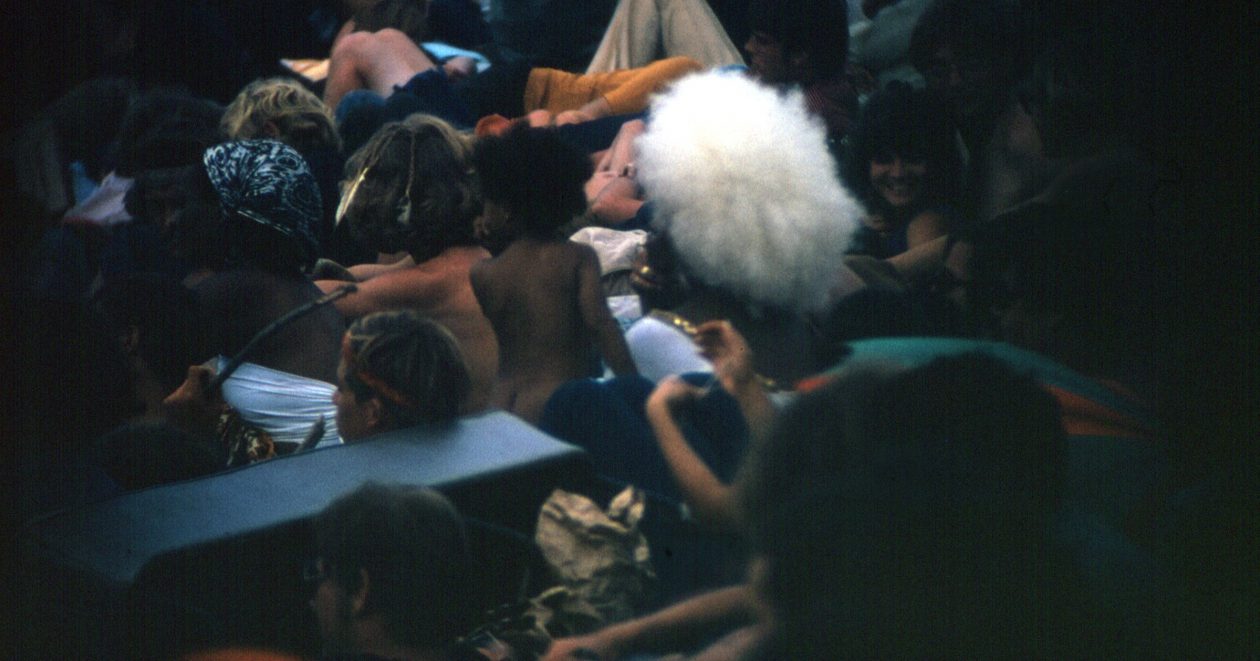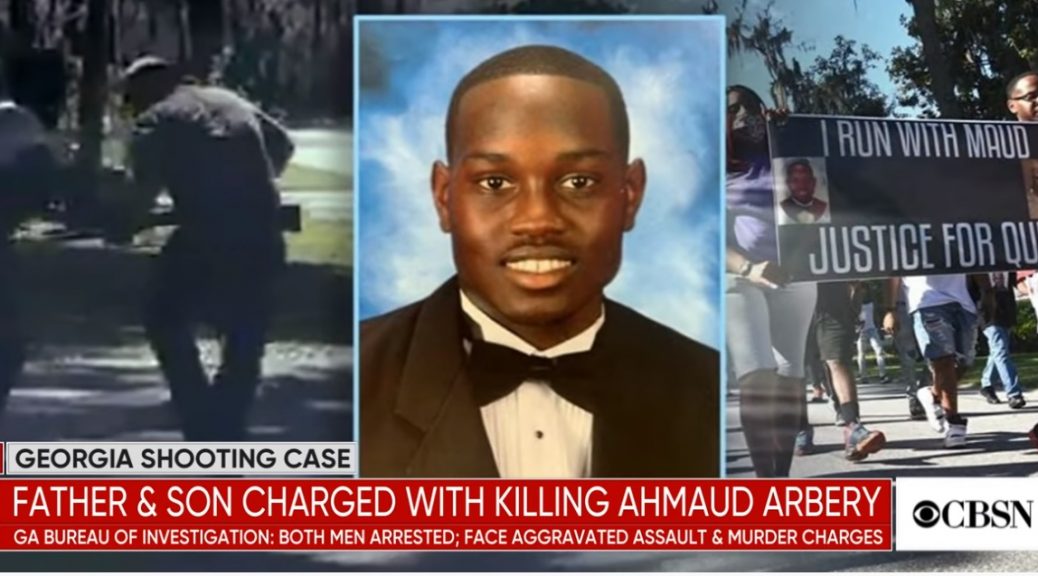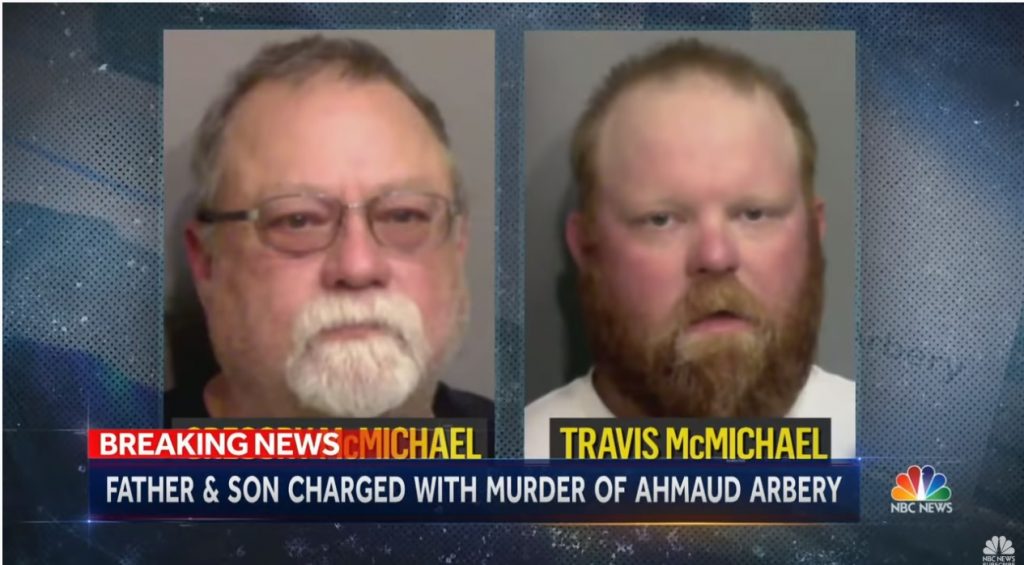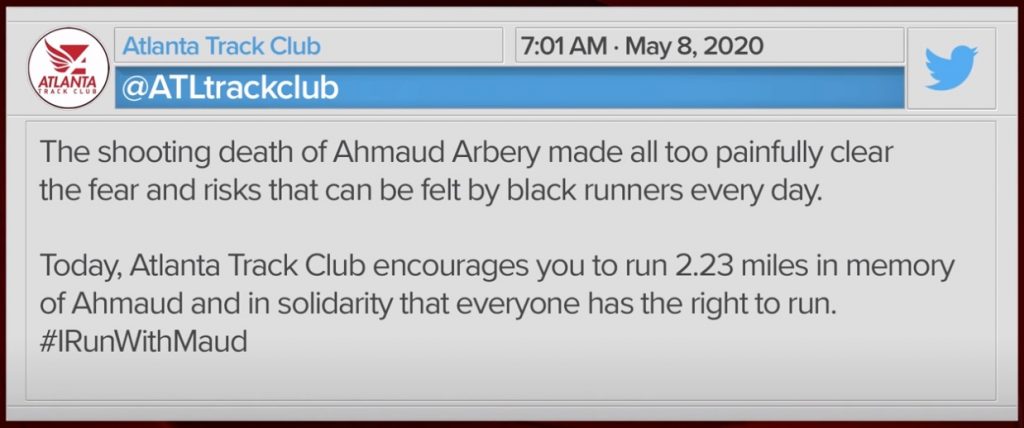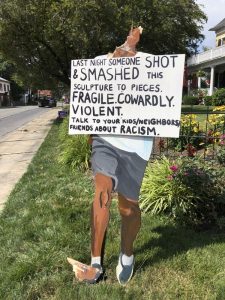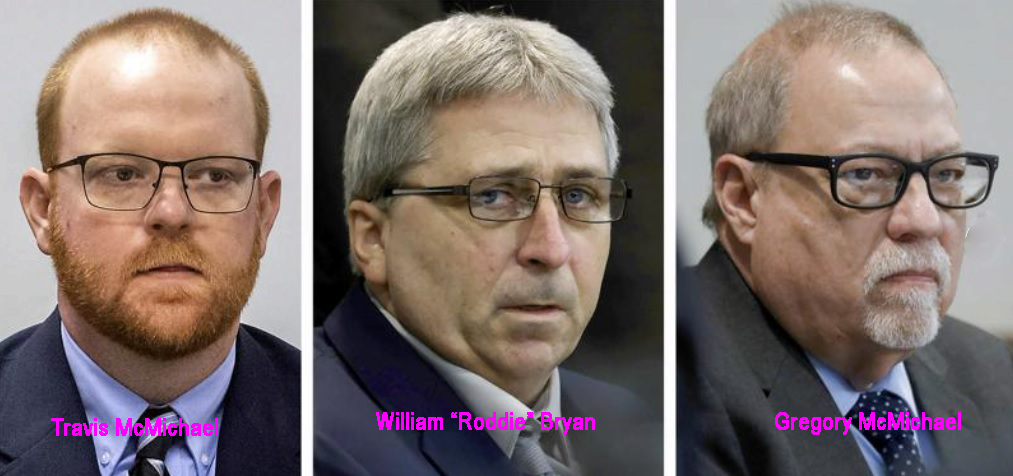Police Kill George Floyd
George Floyd: October 14, 1973 – May 25, 2020
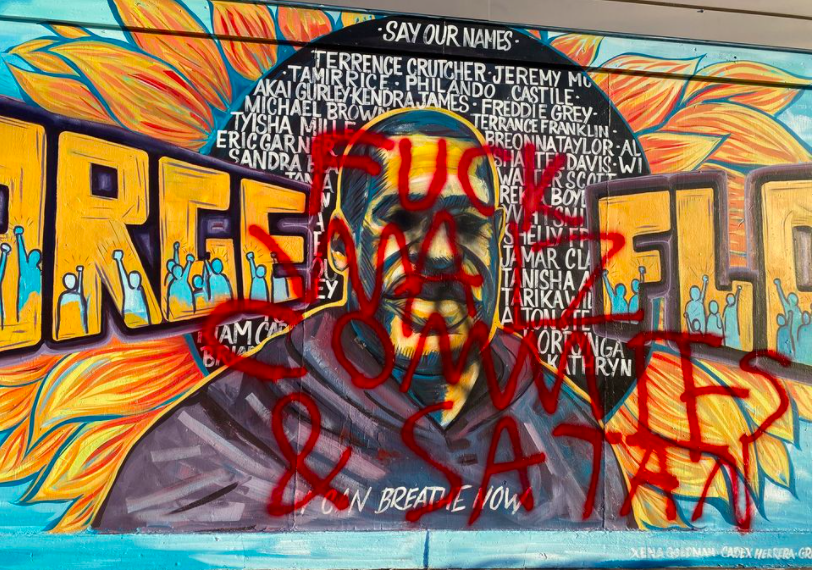
With the story of Ahmaud Arbery still in the news, George Floyd, another black man, was killed while detained by police regarding a possible forgery.
Monday 25 May 2020
Monday 25 May 2020: According to a statement from the Minneapolis Police Department, officers were called to Cup Foods to investigate reports of a forgery.
George Floyd, 46, who was suspected of attempting to spend a counterfeit $20 bill, was in his car when police arrived and ordered him to exit the vehicle.
According to police spokesman John Elder, Floyd “physically resisted officers. Officers were able to get the suspect into handcuffs and noted he appeared to be suffering medical distress.”
A Facebook user posted a video in which Floyd, 46, was killed by police outside the Cup Foods convenience store in Minneapolis, writing: “They killed him right in front of Cup Foods over south on 38th and Chicago! No type of sympathy.”
The video showed a white police officer kneeling on a black man’s neck in the midst of the arrest. The man, Floyd, repeatedly tells the cop that he can’t breathe. After several minutes, the man ceases to move, yet the officer still bears down on his neck. Bystanders call for the officer to let the man go. “He’s not even resisting arrest right now, bro,” one says, while another informs the officer that Floyd’s nose is bleeding and that he looks like he’s about to pass out.
Another video shows the incident from a different angle:
Police Kill George Floyd
Tuesday 26 May
Tuesday 26 May: the FBI and the Minnesota Bureau of Criminal Apprehension began investigating the incident, and the four officers involved were fired. “This is the right call,” Minneapolis Mayor Jacob Frey said on Twitter. “Being Black in America should not be a death sentence,” he wrote on Facebook. “For five minutes, we watched a white officer press his knee into a black man’s neck. Five minutes. When you hear someone calling for help, you’re supposed to help. This officer failed in the most basic, human sense. What happened on Chicago and 38th last night is awful. It was traumatic. It serves as a reminder of how far we have to go.”
Police Kill George Floyd
Wednesday 27 May
Wednesday 27 May: the Minneapolis police department revealed the names of the officers fired after the incident: Derek Chauvin, Thomas Lane, Tou Thao, and J. Alexander Kueng (via the New York Times). Mayor Frey called for prosecutors to file federal charges against the men at a press conference. “I want to see a charge take place,” he said. “I want to see justice for George Floyd.”
Police Kill George Floyd
Thursday 28 May
Thursday 28 May: prosecutors continued to investigate whether or not to charge Derek Chauvin. The lack of action from authorities, however, accelerated protests near the Minneapolis Police Department’s Third Precinct. Participants eventually set fire to the police precinct station, according to the New York Times. Protests also broke out in New York, Denver, Phoenix and Columbus, Ohio. Demonstrators also gathered in Louisville, Kentucky, to protest the death of Breonna Taylor, a black woman who was shot by police while in her own home in March.
NBC reported that Chauvin had been the subject of several police-conduct reports — at least 12 since he started in 2001. Still, according to Minneapolis’ Communities United Against Police Brutality database — which has been cited in various reports on Chauvin’s record — he has received only a few verbal reprimands. Most of the complaints in the database are listed as “closed.”
Police Kill George Floyd
Friday 29 May
THUGS
Friday, 29 May: early in the morning, President Donald Trump denounced protesters, tweeting: “These THUGS are dishonoring the memory of George Floyd, and I won’t let that happen. Just spoke to Governor Tim Walz and told him that the Military is with him all the way. Any difficulty and we will assume control but, when the looting starts, the shooting starts. Thank you!”
Twitter flagged the tweet with a message reading: “This Tweet violated the Twitter Rules about glorifying violence. However, Twitter had determined that it may be in the public’s interest for the Tweet to remain accessible.”
This was the first time Twitter had flagged one of the President’s tweets as questionable. The move cames days after the platform added a fact-check option to some of Trump’s false tweets about mail-in voting, prompting him to threaten to close down Twitter. He then signed an executive order aimed at bolstering the government’s ability to regulate social media sites
Undeterred, the president spent the morning deriding the platform on Twitter, tweeting in the early afternoon: “The National Guard has arrived on the scene. They are in Minneapolis and fully prepared. George Floyd will not have died in vain. Respect his memory!!!”
Protesters across the country blocked highways and clashed with the police
The NY Times reported: chanting “Hands up! Don’t shoot” and “I can’t breathe,” thousands of protesters gathered in cities across the country on Friday night .
-
A large crowd in Washington chanted outside the White House, prompting the Secret Service to temporarily lock down the building. Video on social media showed demonstrators knocking down barricades and spray-painting other buildings.
-
A march in Houston, where Mr. Floyd grew up, briefly turned chaotic as the windows of a police S.U.V. were smashed and at least 12 protesters were arrested. As a standoff continued, the police shut all roads into and out of downtown. “We don’t want these young people’s legitimate grievances and legitimate concerns to be overshadowed by a handful of provocateurs and anarchists,” the city’s police chief, Art Acevedo, said in an interview.
-
Images from news helicopters above San Jose, Calif., showed protesters throwing objects at police officers, blocking a major freeway and setting fires downtown. Mayor Sam Liccardo said in an interview that he watched from City Hall as a peaceful protest — what he called people “expressing their righteous outrage on the injustice in Minneapolis” — turned violent.
-
Demonstrators in Los Angeles blocked the 110 Freeway, marching through downtown and around Staples Center. Local television footage showed police officers clashing with a crowd suspected of vandalizing a patrol car. By 9:30 p.m., L.A.P.D. had declared all of downtown to be an unlawful assembly and was warning residents of the loft districts to stay inside.
-
The police said a 19-year-old man was killed in Detroit after someone opened fire into a crowd of demonstrators late Friday. Earlier, a small group gathered outside Police Headquarters, declaring “Black is not a crime.” The demonstration swelled to more than 1,000 protesters, who blocked traffic while marching on major thoroughfares.
-
In downtown Dallas, protesters and the police clashed during a demonstration blocks from City Hall. Protesters blocked the path of a police vehicle and then started banging on its hood. Officers eventually responded with tear gas, and a flash-bang was later heard.
-
In Portland, Ore., demonstrators broke into the Multnomah County Justice Center and lit a fire inside the building late Friday night, authorities said.
-
Hundreds of protesters converged on Civic Center Park in Denver, waving signs and chanting as Sam Cooke’s “A Change Is Gonna Come” played over a loudspeaker. Some thrust fists in the air and scrawled messages on the ground in chalk, according to a news broadcast.
-
Protesters in Milwaukee briefly shut down part of a major highway, according to WTMJ-TV, and demonstrators shouted “I can’t breathe” — echoing Mr. Floyd’s anguished plea and the words of Eric Garner, a black man who died in New York police custody in 2014.
Police Kill George Floyd
Saturday into Sunday
A day of frustration turns into a night of fury
Saturday 30 May: the NY Times reported that a largely peaceful day of protests descended into a night of chaos, destruction and sporadic violence overnight Saturday as tens of thousands of people poured into streets across the United States to express anger and heartbreak over the death of yet another black man at the hands of the police.
On Sunday morning, the authorities were still sorting through the smoldering wreckage as the vast scope of the unrest came into sharper focus.
Squad cars had been set on fire in Philadelphia, stores were looted in Los Angeles, police officers in Richmond, Va., were injured and hospitalized, and at least one person was killed in Indianapolis, where a deputy police chief said the department had received so many reports of shots fired that they had lost count.
Sunday 31 May
Continued Protests
May 31: NPR reported that protesters staged large-scale demonstrations across the country expressing outrage at the death of Floyd and, more broadly, anger at police brutality. Some cities, including Minneapolis, Atlanta and Seattle, saw clashes with police, buildings and cars set afire, and looting.
By evening, many demonstrations had given way to another night of violence and destruction, with protesters ignoring curfews imposed in dozens of cities. Police used tear gas and stun grenades and fired rubber bullets in attempts to disperse the crowds.
Police Kill George Floyd
Monday 1 June
Autopsies conflict
June 1: The criminal complaint supporting a murder charge for the officer, which referred to the Hennepin County medical examiner’s preliminary findings, said the autopsy had discounted traumatic asphyxia or strangulation as the cause of Mr. Floyd’s death.
Lawyers representing his family presented a very different version of how Mr. Floyd died. In their telling, three officers on the scene killed Mr. Floyd and should be held criminally responsible.
The private autopsy by doctors hired by Mr. Floyd’s family determined that he died not just because of the knee on his neck — held there by the officer, Derek Chauvin — but also because of two other officers who helped pin him down by applying pressure on his back.
The cause of death, according to the private autopsy, was mechanical asphyxia and the manner of death was homicide.
All three officers were fired last week, as was a fourth officer at the scene. [NYT article]
Trump
June 1: in his first remarks from the White House since massive protests have swept the country, President Trump said that the looting and violent demonstrations in reaction to the death of George Floyd in police custody were “acts of domestic terror.”
Speaking in the Rose Garden as protesters and law enforcement held a tense standoff outside, Mr. Trump said he planned for a police and law enforcement presence to “dominate the streets” and said he would respond with an “overwhelming law enforcement presence until the violence has been quelled.”
Afterwards, police officers used tear gas and flash grenades to clear out the crowd so Mr. Trump could visit the nearby St. John’s Church, where there had been a parish house basement fire Sunday night. The president stood in front of the boarded up church posing for photographs with a Bible, after the police dispersed peaceful protesters.
Bishop Mariann Edgar Budde of the Episcopal Diocese of Washington criticized the president’s church visit. She said she was “outraged” that Mr. Trump went to the church “after he threatened to basically rain down military force.”
“The president used a Bible, the most sacred text of the Judeo-Christian tradition, and one of the churches of my diocese, without even asking us, as a backdrop for a message antithetical to the teachings of Jesus and everything that our church stands for,” she said in an interview. [NYT article]
Monday night
June 2: tens of thousands of protesters began another week of demonstrations and disturbances, returning to the streets of cities around the country despite curfew orders, threats of arrest and the words of the brother of George Floyd, who made an emotional plea for the destruction to end.
Police Kill George Floyd
Wednesday 3 June
Less violence
June 3: the NY Times reported that for an eighth day and night, tens of thousands of people staged peaceful protests and impassioned marches across the United States, while the widespread destruction and looting that had followed demonstrations in recent days was largely absent.
President Trump called on states to bring in the military to restore order and combat “lowlifes and losers,” as an infantry battalion from Fort Bragg was dispatched to the nation’s capital as part of a broader show of force. But governors resisted the president’s entreaties, instead bolstering the police presence, changing tactics and imposing curfews to prevent people from using the protests as cover to wreak mayhem.
While demonstrators in many cities defied curfews, they did so peacefully.
No Active Duty Troops
June 3: responding to President’s Trump call for the military, Defense Secretary Mark T. Esper said that he did not think the current state of unrest in American cities warranted the deployment of active-duty troops to confront protesters.
In a Pentagon news conference, Mr. Esper said ordering active-duty troops to police American cities should be a “last resort and only in the most urgent and dire of situations.” He said that, for now, this was not warranted.
Police Kill George Floyd
Minneapolis Police Use of Force
June 3: according to the Minneapolis’s own figures , about 20 percent of its population of 430,000 is black, but when the police get physical — with kicks, neck holds, punches, shoves, takedowns, Mace, Tasers or other forms of muscle — nearly 60 percent of the time the person subject to that force is black.
Since 2015, the Minneapolis police have documented using force about 11,500 times. For at least 6,650 acts of force, the subject of that force was black.
By comparison, the police have used force about 2,750 times against white people, who make up about 60 percent of the population.
All of that means that the police in Minneapolis used force against black people at a rate at least seven times that of white people during the past five years.
Four criminal complaints
June 3: Minnesota Public Radio reported that criminal complaints were formally filed against Derek Chauvin, Tou Thao, J. Alexander Kueng, and Thomas K. Lane.
According to new court documents, in addition to earlier charges officer Derek Chauvin now faces a charge of second-degree murder. Tou Thao, J. Alexander Kueng and Thomas K. Lane, the three other former Minneapolis police officers who were involved in George Floyd’s death faced charges of aiding and abetting murder.
All four police officers were fired one day after Floyd died on Memorial Day. [NPR report]
Police Kill George Floyd
Maurice Lester Hall
June 4: the NY Times reported that Maurice Lester Hall, the longtime friend of George Floyd who was in the passenger seat of Floyd’s car when he was arrested said that Floyd had tried to defuse the tensions with the police and did not resist.
“He was, from the beginning, trying in his humblest form to show he was not resisting in no form or way,” said Hall, 42, who was taken into custody in Houston on Monday and interrogated overnight by Minnesota state investigators, according to his lawyer.
“I could hear him pleading, ‘Please, officer, what’s all this for?’” Mr. Hall said in an interview with Erica L. Green of The New York Times.
Mr. Hall recounted Mr. Floyd’s last moments.
“He was just crying out at that time for anyone to help, because he was dying,” Mr. Hall said. “I’m going to always remember seeing the fear in Floyd’s face, because he’s such a king. That’s what sticks with me: seeing a grown man cry, before seeing a grown man die.”
Protests coalesce into a unified push for reforms
June 6: Demonstrations that began as spontaneous eruptions of outrage after the death of George Floyd at the hands of the Minneapolis police two weeks ago coalesced this weekend into a nationwide movement calling for police reforms and racial justice.
Tens of thousands gathered in big cities like New York and Seattle and small towns like Vidor, Texas, and Marion, Ohio — in swelling crowds that have been multiethnic, spanning generations and overwhelmingly peaceful. The movement has also spread around the world, with protests this weekend in Africa, Asia, Australia and Europe. [NYT article]
Floyd Funeral
June 9: the Guardian reportedthat George Floyd’s life was celebrated at his funeral with eulogies that honored him as a father, brother, athlete and mentor whose death sparked a global reckoning over police brutality and racial prejudice.
Crowds descended on a church in Houston, Texas, after Floyd’s body was returned to his childhood hometown to be laid to rest in a cemetery in suburban Pearland next to his mother, whom he called out for as he lay dying with a police officer’s knee on his neck in May.
Police Kill George Floyd
NASCAR Bans Confederate Battle Flag
June 10: NPR reported that NASCAR banned the Confederate battle flag at all of its events and properties. In a tweet, the stock car racing organization said the presence of the flag “runs contrary to our commitment to providing a welcoming and inclusive environment for all fans, our competitors and industry.”
One of its popular drivers (and the only full-time African American racing in its top circuit), Bubba Wallace had repeatedly called for the flag’s ouster.
New Transcripts Detail Last Moments for George Floyd
July 8: the NY Times reported that transcriptsof the incident’s Minneapolis police body camera footage were filed in state court as part of an effort by Thomas Lane, one of the officers on the scene, to have charges that he aided and abetted Mr. Floyd’s murder thrown out by a judge.
The transcripts revealed that Mr. Floyd uttered “I can’t breathe” not a handful of times, as previous videotapes showed, but more than 20 times in all. He cried out not just for his dead mother but for his children too. Before his final breaths, Mr. Floyd gasped: “They’ll kill me. They’ll kill me.”
Transcripts also show that as Mr. Floyd shouted for his life, an officer yelled back at him to “stop talking, stop yelling, it takes a heck of a lot of oxygen to talk.”
Police Kill George Floyd
$ Settlement
March 12, 2021: the city of Minneapolis agreed to pay $27 million to settle a civil lawsuit from George Floyd’s family over the Black man’s death in police custody, as jury selection continued in former officer Derek Chauvin’s murder trial.
Council members met privately to discuss the settlement, then returned to public session for a unanimous vote in support of the massive payout. It easily surpassed the $20 million the city approved two years ago to the family of a white woman killed by a police officer.
Floyd family attorney Ben Crump called it the largest pretrial settlement ever for a civil rights claim, and thanked city leaders for “showing you care about George Floyd.”
“It’s going to be a long journey to justice. This is just one step on the journey to justice,” Crump said. “This makes a statement that George Floyd deserved better than what we witnessed on May 25, 2020, that George Floyd’s life mattered, and that by extension, Black lives matter.” [AP article]
Jury
March 24, 2021: the final juror was chosen, wrapping up a process that took more than two weeks.
Attorneys and the judge worked through more than 100 people, dismissing most because they acknowledged strong views about an encounter that was captured on bystander video. [AP article]
Trial Underway
April 1: On the fourth day of the trial, Sgt. David Pleoger, who supervised Derek Chauvin testified Chauvin and other police officers should have stopped holding George Floyd down once he became unresponsive.
“When Mr. Floyd was no longer offering up any resistance to the officers, they could have ended their restraint,” said Pleoger, who is now retired. In response to a question from a prosecutor, he agreed that police officers should not restrain someone who is handcuffed and no longer resisting.
Pleoger said that he had spoken with Mr. Chauvin moments after Mr. Floyd was taken away in an ambulance, and that Mr. Chauvin had not mentioned the pressure to Mr. Floyd’s neck in that conversation. [NYT article]
Veteran Police Testimony
April 2: the NY Times reported that Lt. Richard Zimmerman had seen hundreds of crime scenes, interviewed scores of witnesses and made his share of arrests over more than 35 years working cases in Minneapolis, but when Lt. Richard Zimmerman watched a video of one of his colleagues kneeling on George Floyd’s neck, he saw what he described as a “totally unnecessary” violation of department policy.
“Pulling him down to the ground face down and putting your knee on a neck for that amount of time, it’s just uncalled-for,” testified Zimmerman, who was the longest-serving officer on the Minneapolis police force.
April 5: Minneapolis Police Chief Medaria Arradondo, who called George Floyd’s death “murder” soon after it happened. testified that Officer Derek Chauvin had clearly violated department policy when he pinned Floyd’s neck beneath his knee for more than 9 minutes.
Continuing to kneel on Floyd’s neck once he was handcuffed behind his back and lying on his stomach was “in no way, shape or form” part of department policy or training, “and it is certainly not part of our ethics or our values,” Arradondo said on day six of Chauvin’s murder trial. [AP article]
Defense Strategy
April 13: Derek Chauvin’s lawyer, Eric J. Nelson, presented a video of the May 2019 arrest and questioned the paramedic who treated Mr. Floyd that day. He asked a woman who was with him the day he died about how Mr. Floyd fell asleep in the car and was difficult to rouse. He reviewed the signs of excited delirium, a condition often attributed to using stimulants.
Other planks of the defense emerged as well, including suggestions that the bystanders who tried to intervene were threatening and that Mr. Chauvin’s behavior was reasonable in the circumstances. [NYT article]
Chauvin Speaks/Defense Rests
April 15: for the first time in nearly three weeks of testimony, the former officer Derek Chauvin spoke in the courtroom. Nearing the end of the defense’s case, Mr. Chauvin’s lawyer, Eric J. Nelson, asked Mr. Chauvin whether he would like to testify in his own defense.
Mr. Nelson said he and Mr. Chauvin have had repeated conversations on the matter, including a “lengthy meeting” the night before. Mr. Chauvin, who removed his mask to answer Mr. Nelson’s questions, chose to waive his right to testify. [NYT article]
Later that same day, the prosecution and defense lawyers rested their cases. Closing arguments began the following Monday, April 19. [NYT article]
Guilty x3
April 20: the jury found Derek Chauvin guilty of murder on all three counts.
The verdict, which could send Chauvin to prison for decades, was a rare rebuke of police violence, following case after case of officers going without charges or convictions after killing Black men, women and children. [NYT article]
Chauvin Sentenced
June 25, 2021: Judge Peter A. Cahill sentenced Derek Chauvin to 22 and a half years. In delivering Chauvin’s sentence Cahill referred to the “particular cruelty” of the crime.
Judge Cahill issued a 22-page memorandum about his decision, writing, “Part of the mission of the Minneapolis Police Department is to give citizens ‘voice and respect.’” But Mr. Chauvin, the judge wrote, had instead “treated Mr. Floyd without respect and denied him the dignity owed to all human beings and which he certainly would have extended to a friend or neighbor.” [NYT article]
Federal Trial
Chose not to intervene
January 24, 2022: Samantha Trepel, special litigation counsel from the Department of Justice’s Civil Rights Division said in opening statements today that the three former Minneapolis Police officers who helped Derek Chauvin restrain George Floyd in May 2020 committed federal crimes when they ignored Floyd’s repeated pleas of “I can’t breathe.”
Guilty
All were convicted of depriving Floyd of his civil rights while acting under government authority when they failed to give him medical aid. Kueng and Thao, additionally, were convicted of not intervening to stop their fellow officer Derek Chauvin from using excessive force. They had pleaded not guilty. [NBC News article]
Sentenced
July 7, 2022: Derek Chauvin was sentenced to 21 years in federal prison. He was sentenced for using excessive force under color of law against both George Floyd, the man who died in the encounter, and a 14-year-old boy, also Black, who was injured in an unrelated, though similar, incident.
With time already served deducted, Chauvin’s sentence amounted to 20 years and five months, near the lower end of the range of 20 to 25 years prescribed by the sentencing guidelines. His federal and state sentences were to be served concurrently.
In imposing the sentence, Judge Paul Magnuson of U.S. District Court in St. Paul said . ““I really don’t know why you did what you did, but to put your knee on another person’s neck until they expired is simply wrong, and for that conduct you must be substantially punished. You absolutely destroyed the lives of three other young officers” who were also involved, the judge added. [NYT article]
Attempted Murder
November 24, 2023: inmate John Turscak stabbed Chauvin 22 times. Chauvin will survive.
December 1, 2023: authorities charged John Turscak with attempted murder. He told investigators he had targeted Chauvin because of his notoriety for killing George Floyd. [AP story]
Police Kill George Floyd, Police Kill George Floyd, Police Kill George Floyd, Police Kill George Floyd, Police Kill George Floyd, Police Kill George Floyd, Police Kill George Floyd, Police Kill George Floyd, Police Kill George Floyd, Police Kill George Floyd, Police Kill George Floyd, Police Kill George Floyd, Police Kill George Floyd, Police Kill George Floyd, Police Kill George Floyd, Police Kill George Floyd,
